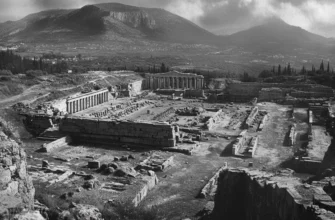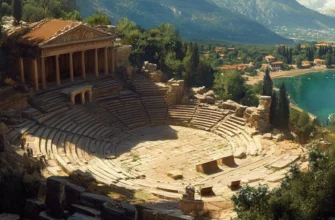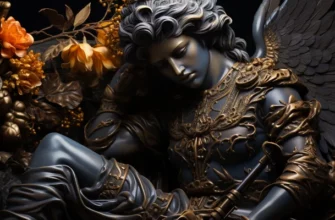Persephone, daughter of Zeus and Demeter, is known as the goddess of the underworld and harvest. Legends link her to her abduction by the god Hades, which led to her status as Hades’ wife. She symbolizes the cycle of life and death, influencing ancient Greek ideas about natural cycles and transformation. Her cult was important in ancient Greek rituals and mysticism, and she also played a significant role in art and literature. Modern culture also retains an interest in this mysterious goddess, using her image in literature and art.
Legends and myths
In ancient Greek mythology, there are several well-known legends and myths associated with Persephone. One of the most famous stories tells how the god Hades kidnapped Persephone from the earth and took her to his underground kingdom. Persephone’s desperate mother, the goddess of fertility Demeter, condemns the world to famine, demanding the return of her daughter. Thanks to the mediation of Hermes, the god of thunder, an agreement was reached whereby Persephone would spend half the year on earth with her mother, during which spring and summer would come, and the other half of the year in the underworld with her husband, during the night of death and winter. This legend symbolizes the natural cycles of life, death, and rebirth, which are reflected in natural phenomena.
Role in the pantheon
Persephone is an important goddess in ancient Greek mythology who played a key role as the goddess of the underworld and harvest. Her personification was associated with the spring and autumn cycles of life, symbolizing the eternal circle of birth, death, and rebirth in nature.
According to legend, her abduction by the god Hades caused drought and famine on earth, which explains the seasonal changes in nature. Her connection with Demeter, the goddess of agriculture and harvest, emphasized the importance of their tandem for the fertility of the earth and abundance.
The cult of Persephone had a significant influence on ancient Greek society, finding expression in various rituals and celebrations related to the cycles of nature and the harvest. She became a symbol of an integral part of the Greek worldview, giving deep meaning to the understanding of life and death. Her cultural significance continues to be reflected in contemporary literature, art, and culture, supporting the perception of the cyclical nature of life in the modern world.
The myth of Persephone and Hades
The myth of Persephone and Hades is one of the most famous in ancient Greek mythology. According to legend, while Persephone was picking flowers in a field, the earth opened up and Hades, the god of the underworld, sprang out of a dark abyss. He kidnapped the girl and took her to his kingdom.
In her anger and grief, Demeter, Persephone’s mother, stopped all natural processes, which led to a barren landscape and famine on earth. The gods were forced to intervene to resolve the conflict. An agreement was reached whereby Persephone would spend half the year with her mother on earth and the other half in the underworld with Hades. This myth explains the seasonal changes in nature and symbolizes the cycle of life, death, and rebirth.
Origin of the myth
The myth of Persephone and Hades has deep roots in ancient Greek mythology and culture. It is believed that the origin of this myth is connected with the ancient rituals of spring and autumn sowing that took place in Ancient Greece. These rituals were accompanied by various rituals associated with the fertility of the earth and the harvest.
Some researchers believe that the myth of Persephone and Hades may have its roots in local legends and myths that were told in ancient Greek cities, especially in regions where rituals associated with the changing seasons and the fertility of the land took place. This myth embodies the ancient Greek view of the natural cycles of life and reflects the ancient Greek perception of changes in nature that affected their daily lives and agricultural practices.
Important symbols and motifs
In the myth of Persephone and Hades, there are several important symbols and motifs that have deep meanings:
Seasonal changes: The abduction of Persephone and her stay in the underworld with Hades explains seasonal fluctuations in nature, such as the changes of spring, summer, autumn, and winter.
The cycle of life and death: The myth symbolizes the eternal cycle of life, death, and rebirth. Persephone’s journey from the underworld to the earth and back reflects the natural process of birth, decay, and rebirth.
The struggle between the gods: The conflict between Demeter and Hades highlights the eternal struggle between the forces of life and death, light and darkness, fertility and the negative forces of the underworld.
Agreement and compromise: The agreement that the gods were forced to make to resolve the conflict shows the need for balance between natural forces and human needs.
These symbols and motifs help us understand the deeper meaning of the myth of Persephone and Hades and its influence on ancient Greek culture and thought.
Persephone’s role in rituals and culture
Persephone played an important role in ancient Greek rituals and culture, especially in the context of harvest and seasonal cycles. Her cult was associated with religious rituals celebrated in various regions of Ancient Greece. She was perceived as the goddess of fertility and the fertility of the earth, and her worship was associated with favorable harvests and prosperity.
The rites dedicated to Persephone included various rituals and ceremonies involving sacrifices, prayers, and special celebrations during different seasons of the year. Her cult also inspired the creation of various works of art that reflected her influence on ancient Greek art and literature.
Persephone also became an important symbol for understanding natural cycles and the cyclical nature of life in the ancient world. Her role in rituals and culture emphasizes the importance of natural phenomena and cycles for ancient Greek society.
Holidays and rituals associated with Persephone
Holidays and rituals associated with Persephone often encompassed seasonal changes and cycles of nature. Some of these included:
The Eleusinian Mysteries: These were secret rituals associated with the cult of Demeter and Persephone that took place in Eleusis. They included initiation rites and rituals that symbolized the cycle of life, death, and rebirth.
The Telphinia: These were rituals dedicated to Persephone that were held in Telphia, where her cult was particularly widespread. They included various prayers, sacrificial rites, and special ritual actions aimed at supporting the fertility of the earth.
Feast of Persephone and Demeter: This festival was celebrated in various regions of Ancient Greece, where rituals and ceremonies were held in honor of these goddesses. They included parades, religious rites, and special prayers aimed at ensuring abundance and fertility.
These festivals and rituals reflected the importance of Persephone in ancient Greek religion and culture, as well as supporting the perception of seasonal cycles and the fertility of the earth.
Influence on Greek art and literature
Persephone had a significant influence on Greek art and literature, appearing in various artistic and literary works. Her image was often depicted on vases, reliefs, and other works of art, reflecting her role in the pantheon and the myths associated with her.
In Greek literature, the myth of Persephone and Hades was widely used as a theme for tragedies, poems, and other genres of literature. Literary works often viewed her abduction and life in the underworld as symbols of natural cycles and universal themes of life and death.
The image of Persephone also played an important role in shaping motifs and symbolism in Greek art and literature, inspiring researchers and artists to creatively interpret and reimagine mythological themes in their works. She has become an integral part of the cultural heritage of Ancient Greece and continues to influence contemporary art and literature, demonstrating the relevance and universality of her symbolism for the modern world.
Contemporary perceptions of Persephone
The modern perception of Persephone remains multifaceted and broad in its interpretation. Her myth and symbolism continue to be used in literature, art, and popular culture to explore themes of life, death, and rebirth.
In contemporary works, Persephone is often used to reflect inner struggles and the search for personal identity. Her image sometimes embodies the idea of strong female will and power that can withstand trials and tribulations.
Furthermore, the reinterpretation of the myth of Persephone in modern culture is seen as an opportunity to explain complex aspects of the human experience, such as transitions, change, and loss. Her story has become an important source of inspiration for the reclaiming of female strength and independence in the modern world.
Finally, in the modern world, Persephone remains an important figure for exploring the relationship between humans and nature and recreating the cyclical nature of life. Her symbolism reminds us of the importance of balance and harmony in human existence, as well as the importance of natural cycles for our understanding of the world.
Persephone and her story are often used in contemporary culture to explore a wide range of themes, including the forces of nature, female power, sacrifice, devotion, and transformation. She appears in literature, film, and other contemporary media as a powerful symbol that inspires and intrigues audiences.
In literature and film, the character of Persephone is often used to create complex, multifaceted female characters who explore themes of power, devotion, and self-realization. She can be portrayed as a strong, independent woman who stands up to challenges, or as a symbol of an inner struggle with her own demons.
In addition, in contemporary music and visual culture, Persephone can be represented as a symbol of nature, cyclicality, and rebirth. Her image has significantly influenced the creation of musical works, video art, and fashion trends that reflect inspiration and attention to natural processes and female power.
In modern culture, Persephone remains an important symbol that inspires and stimulates reflection on important aspects of life, nature, and the female essence.
Conclusion
Persephone – ancient Greek goddess is an important figure in ancient Greek mythology and culture. Her image symbolizes the cycle of life, death, and rebirth, and reflects the importance of natural cycles for understanding the world. Her abduction and coexistence with Hades, the god of the underworld, became the basis for explaining seasonal changes in nature.
Persephone also played an important role in religious rituals and celebrations related to the fertility of the earth and the harvest. Her image remains relevant in the modern world, inspiring artists, writers, and cultural creators to explore themes of female power, inner struggle, and the cyclical nature of life. Persephone’s influence on culture remains significant, demonstrating the universality and importance of her symbolism for the modern world.








